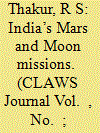| Srl | Item |
| 1 |
ID:
139177


|
|
|
|
|
| Summary/Abstract |
The Moon and Mars have stirred the imagination of space scientists since ages because of their relative proximity to Earth, as compared with other heavenly bodies. The Moon, located at a distance of 38,000 km, is the heavenly body nearest to the Earth. It is natural that our satellite remained the object of the first research since the beginning of the Space Age. Mars, the fourth planet in the solar system after Earth, has a year of 687 days and a day which differs from the Earth-day by a little less than half an hour; it is smaller as well as lighter than the Earth and less dense too with its gravity just about 38 percent of the gravity on Earth. It has two satellites: Phobos and Deimos. Soon after the dawn of the Space Age in 1957, both the US and erstwhile USSR initiated numerous projects to carry out wide-sweeping reconnaissance of the solar system, including the Moon and Mars, during the 1960s and 1970s. This was followed by increasing European and Japanese activities in the area of interplanetary exploration in 1980.1 Since then, there has been an overall continuity in nations attempting interplanetary exploration. India, with its robust space programme, has been making steady progress in deep space exploration, along with other space-faring nations right from the beginning.
|
|
|
|
|
|
|
|
|
|
|
|
|
|
|
|
| 2 |
ID:
191588


|
|
|
|
|
| Summary/Abstract |
As contestation in outer space has evolved into increased militarization since the Cold War era, multiple stakeholders have come to play a significant role in shaping the international regime governing activities of State and non-State actors in outer space. India has interacted with this international regime in a dynamic manner, and currently contributes about 2 per cent to the US$ 360 billion global space industry. Its own security compulsions in outer space are shaped by its national interests vis-a-vis data collection, C4ISR, satellite communications, and of course, deterrence against the rising military might of hostile countries in its neighbourhood—China and Pakistan. In this light, this article looks at the potential of India’s domestic material and policy-based space architecture, including the functioning of ISRO and its collaboration with the private sector, as well as India’s current space-based assets and ASAT capabilities. On the basis of this assessment of India’s current institutional and infrastructural assets for outer space, the article also attempts to chart a trajectory forward for India’s space policy and counter-space capabilities.
|
|
|
|
|
|
|
|
|
|
|
|
|
|
|
|